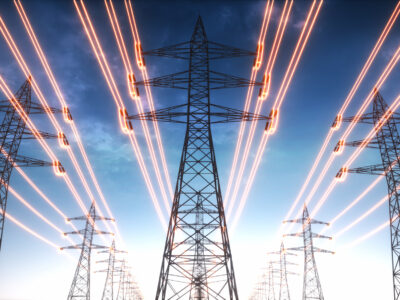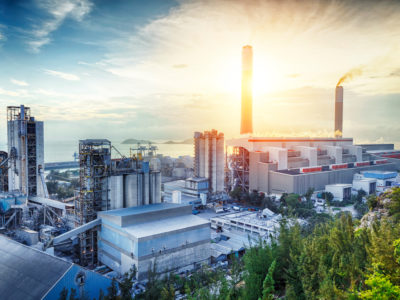Bitcoin mining and the power industry: impacts and outlook
You’ve no doubt heard of Bitcoin, the digital currency ecosystem that’s recently been getting attention for its steeply ascendant price, as well as for its impacts on the energy industry and the environment. While it was initially slow to take hold, adoption of Bitcoin is growing fast, prompting questions about its impact on the power industry and sustainability.
Here, we’ll take a look at the relationship between Bitcoin and the power industry, and explore how Bitcoin mining might affect water use in the energy sector.

What is Bitcoin mining and how does it work?
As a purely digital currency, bitcoins aren’t minted like traditional coin or paper currency, but are instead created through a computing process known as “mining.” Mining is baked into Bitcoin’s underlying database, known as blockchain. The blockchain functions like a massive decentralized ledger, and consists of interlinked blocks that are identified by a unique sequence of letters and numbers known as a cryptographic hash. Bitcoin miners essentially work to figure out the hash for new blocks. When successful, the miner is rewarded with the proceeds from the new block, including a set number of bitcoins, as well as future transaction fees.
To succeed, a miner will need to find an acceptable hash solution from billions or even trillions of possibilities, and will need to find the solution more quickly than any other miner. For this reason, miners need access to high-powered computers—and lots of energy to power them.
Bitcoin mining and the power industry
With each bitcoin currently valued at nearly $50,000 USD, Bitcoin mining has become intensely competitive. So competitive, in fact, that most individual miners are now joining mining pools in order to enhance their collective computing power and speed. Around the world, entire data centers are popping up solely for Bitcoin mining, some of which with capacities rivalling those of major cloud providers.
Of course, all this computing power consumes a lot of electricity. The University of Cambridge estimates that Bitcoin consumes around 80 TW energy per year, a figure that has shrunk somewhat from a peak earlier this year, but still well exceeds the total power use of many small nations. The growth trend in Bitcoin mining is expected to continue for the next few years at least, and will likely play a small role in the world’s increasing demand for energy.
Exactly how Bitcoin miners source the energy they need to power their mining operations varies significantly from one enterprise to the next. Some miners draw from the existing power grid, while others set up their own dedicated electrical generation facilities by reopening or rehabbing old power plants, or by building new ones. In some cases, miners are even able to sell electricity back to the grid. Miners are known to use fossil fuels, as well as hydropower, solar, and wind technologies, and typically locate their operations where energy can be found most affordably and reliably. Due to the secretive culture of crypto investors, however, it is difficult to know the precise mix of energy sources used in Bitcoin mining, and more difficult still to precisely calculate the environmental impacts of Bitcoin mining.

Bitcoin mining and water resources
Bitcoin miners have frequently attracted controversy, both from local communities and environmental conservation groups. Often, concerns have to do with water consumption as well as disruption to local waterways. Indeed, energy generation is among the most water-intensive industries that exist today, as power plants use lots of water for steam generation and for cooling. Bitcoin miners, who are perceived as adding to this burden, increasingly face legal and regulatory hurdles to open and operate their facilities, as well as opposition from local communities.
This is especially true for Bitcoin mining operations that rely on older technologies, such as once-through cooling systems, which draw and discharge large volumes of water from surface waterways. Additionally, as regulations tighten and costs for sourcing and discharging water continues to increase, Bitcoin miners and power plant operators alike may do well to get familiar with strategies to reduce water used for electrical generation, like replacing open cooling systems with closed, using recycled water, or optimizing efficiency of existing cooling systems, for example. While such changes can entail significant capital costs, the investment may well be worth it as costs for water and wastewater discharge compliance rise as expected in the coming years and decades.
How can SAMCO help?
SAMCO has over 40 years of experience in custom-designing and manufacturing water treatment systems for power generation applications, so please feel free to reach out to us with your questions. With water minimization strategies, considering water quality and associated treatment go hand in hand. SAMCO can review your goals and help your facility plan a treatment solution.
For more information or to get in touch, contact us here to set up a consultation with an engineer or request a quote. We can walk you through the steps for developing the proper solution and realistic cost for optimizing water use at your electrical generation facility.
Head on over to our blog to learn more about industrial filtration and process separation technology. Some articles that might be of specific interest to you include:
- How to Increase Your Industrial Cooling Tower Efficiency
- Why Your Industrial Facility Should Plan for Water Shortages Sooner Rather Than Later
- Industry and Water Shortages: Is Your Facility Ready?
- Can Your Facility Save Money by Reducing Its Water Consumption?
- Five Ways Your Industrial Facility Can Conserve Water and Plan Ahead for Shortages
